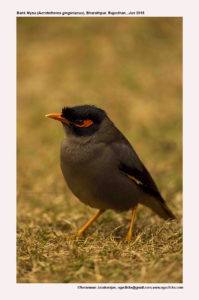
Bank Myna Acridotheres ginginianus
Etymology:
- Acridotheres : Greek word akris- locust; theras–hunter { Locust hunter}
- Ginginianus: From Gingi , Coramndal coast in India
Vernacular Names: Sind: Lali, Hindi: Ganga myna, Barad Myna, Sans: Ganga Saarika, Pun: Ganga gutar, U.P: Darytamyna, Bi: Baradmyna, Ben: Gang salik, Nepal: Bardimyna, Guj: Shirajikabar, Ghodakabar, Mar: Ganga Myna
Distribution in India:Widespread Resident in North, West, Central and some parts of East of India
Description: Size of 20-22 cm. It is a smallish myna with forehead feathers bristly and directed to mid-line to form short frontal crest; feathers of crown and nape elongate and lanceolate. Forehead, crown, nape and cheek are glossy black, upperparts grey; upperwing is glossy black, there is green iridescence on secondaries, bases of primaries white, becoming chestnut-brown on inner feathers, chestnut primary coverts; tail glossy black, retrices with chestnut tips , chin grey, breast grey with cinnamon tinge, center of belly and undertail-coverts cinnamon, flanks grey with cinnamon wash; underwing-coverts chestnut; iris intense brown-red, bare skin behind and below eye brick-red; bill orange-yellow; legs yellow. Both sexes look similar.
Habitat: It is found closely associated with man-modified habitats, both agricultural areas and cities. On farmland often found with cattle, and favours wetter areas near irrigation canals and rivers; in cities found at refuse dumps, sewage works, and wherever food likely to be discarded.
Food Habits: It is omnivorous, diet incorporating animal food, fruit, seeds, and food waste discarded by humans. Animal food includes frog tadpoles, small snails, earthworms, ticks, spiders, ants and wasps and other small insects. Fruits eaten include figs, grapes, mulberries, peas and chilies. It occasional feeds on nectar. The nestlings are fed with 95% animal food, mostly insects. It forages mostly on ground; often follows the plough and accompanies cattle. It settles on cattle and removes ticks from them.
Breeding Habits: They breed in Mar- Aug. They are Monogamous and colonial breeders. They excavate own tunnel in bank of river, tunnel can be up to 1 m long and ending in broader chamber, lined with straw, feathers, pieces of sloughed snakeskin, polythene and other material. They lay a clutch of 3–6 eggs. The incubation is done by both sexes, female doing more for a period 13 day. Both parents feed chicks and remove faecal material. The nestling period is for 20–22 days.